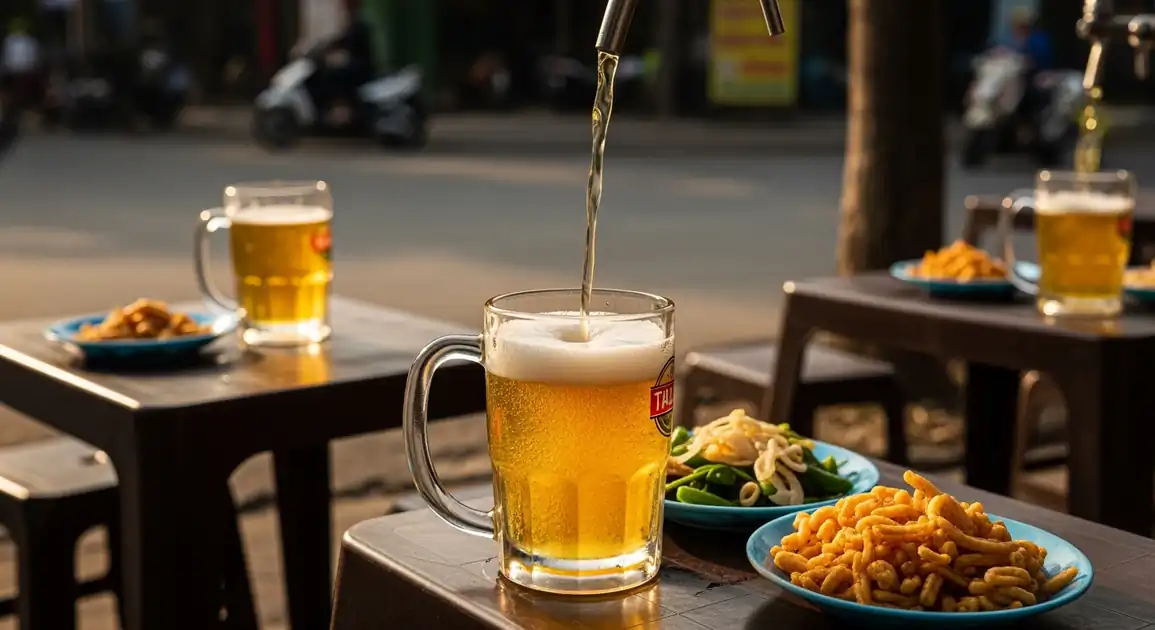Bia Hoi (Fresh Beer)
Bia Hơi

Description
Bia Hoi is a quintessential part of Vietnamese drinking culture, particularly in the north. While Hanoi is the undisputed capital of Bia Hoi, the fresh beer culture has spread throughout the country, with regional variations in serving styles and accompanying foods. Each city has developed its own Bia Hoi neighborhoods and traditions.
Dietary Information
Serving information
Serving style
Typically served in small 300-330ml glasses, often slightly wider at the top than bottom. Beer is poured with a small head of foam and sometimes kept cool with ice around the glass or keg (never in the beer itself).
Quick facts
Most Bia Hoi places open around 10 AM - 11 AM and continue serving until late evening (10 PM - 11 PM).
Safety Tips
What to Look For
-
High customer turnover
Busy establishments ensure the beer keg is fresh and hasn't been sitting for days, as Bia Hoi has no preservatives and should be consumed within 24-48 hours of brewing.
-
Clear delivery marking on kegs
Some venues mark their kegs with delivery dates or times. Ideally, the keg should have been delivered that same day.
-
Clean glasses that are rinsed before serving
Staff typically rinse glasses with water before pouring beer. This traditional practice helps ensure hygiene and proper beer temperature.
-
Beer with light golden color and decent head of foam
Fresh Bia Hoi should have a clear, light golden appearance with a small but noticeable head when poured. Cloudy or flat beer may indicate poor quality.
What to avoid
-
Very empty venues with few customers
Lack of customers often means the beer isn't being consumed quickly enough, which is problematic for a preservative-free product with short shelf life.
-
Unusually dark or cloudy beer
Bia Hoi should be light golden and relatively clear. Excessive cloudiness or dark color can indicate old beer or poor brewing conditions.
-
Beer that tastes sour or overly bitter
Fresh Bia Hoi has a mild, slightly sweet taste. Sour notes typically indicate that the beer has begun to spoil due to its lack of preservatives.
-
Dirty glasses or unhygienic serving conditions
While Bia Hoi venues are simple, basic hygiene standards should still be observed, particularly with glassware.
Price information
Price range
Budget tips
- Prices increase significantly in tourist areas - venture a few blocks away for better rates.
- Many places charge by the keg or tower for groups, which offers better value.
- Afternoon prices (before 5 PM) are often lower than evening prices.
- Venues outside city centers typically offer lower prices.
Value indicators
- Clean, regularly rinsed glasses.
- Complementary peanuts or small snacks.
- Freshly tapped kegs.
- Efficient service even when busy.
Where to Find This Dish
Beer Streets
Many cities have developed streets or areas known for concentrations of Bia Hoi establishments.
Local markets, Old town/city centers, Working-class neighborhoods
Late Afternoon, Evening
Street Corners
Traditional locations for standalone Bia Hoi spots, often at busy intersections.
Busy intersections, Wide sidewalks
Late Afternoon, Evening
Vendor Tips
- Prices are rarely displayed prominently - ask before ordering to avoid surprises.
- Some places require food purchases alongside beer - check if there's a minimum order.
- Staff may continually refill your glass until you cover it with a napkin or say 'Không, cảm ơn' (No, thank you).
How to Order
Regional Variations
-
Traditional Bia Hoi
(Bia Hơi Truyền Thống)
The classic version with around 3-4% alcohol content, light bodied with minimal carbonation, served fresh from the keg at simple street establishments.
-
Bia Hoi with Lime
(Bia Hơi Chanh)
Some vendors offer the option to add a squeeze of fresh lime to your beer, adding a refreshing citrus note that works well with the light beer, especially in hot weather.
-
Bottled Fresh Beer
(Bia Tươi Chai)
Some breweries bottle their fresh beer for slightly longer shelf life (3-5 days). While not traditional Bia Hoi, it offers a similar fresh beer experience with slightly more consistency.
-
Craft Bia Hoi
(Bia Hơi Thủ Công)
A modern twist where some microbreweries in Hanoi produce craft-style fresh beers with more complex flavor profiles, though at higher prices than traditional Bia Hoi.
Cultural context
History
Bia Hoi emerged during the 1950s, influenced by Czechoslovakian brewing techniques introduced during Vietnam's communist era. Unlike commercial brewing, Bia Hoi's production remained small-scale and local, becoming an integral part of northern Vietnamese social life. The tradition of sidewalk beer drinking flourished as an affordable leisure activity, particularly in Hanoi, evolving into the cultural institution it is today, while maintaining its distinctly Vietnamese character despite the later influx of international beer brands.
Local significance
Bia Hoi represents Vietnamese social drinking culture at its most accessible and egalitarian. It's a democratic institution where people from all walks of life gather to socialize in an unpretentious setting.
Eating customs
- Beer is almost always accompanied by snacks ('đồ nhắm').
- Popular pairings include roasted peanuts, dried squid, tofu dishes, and various grilled meats.
- Food is typically shared among the table rather than ordered individually.